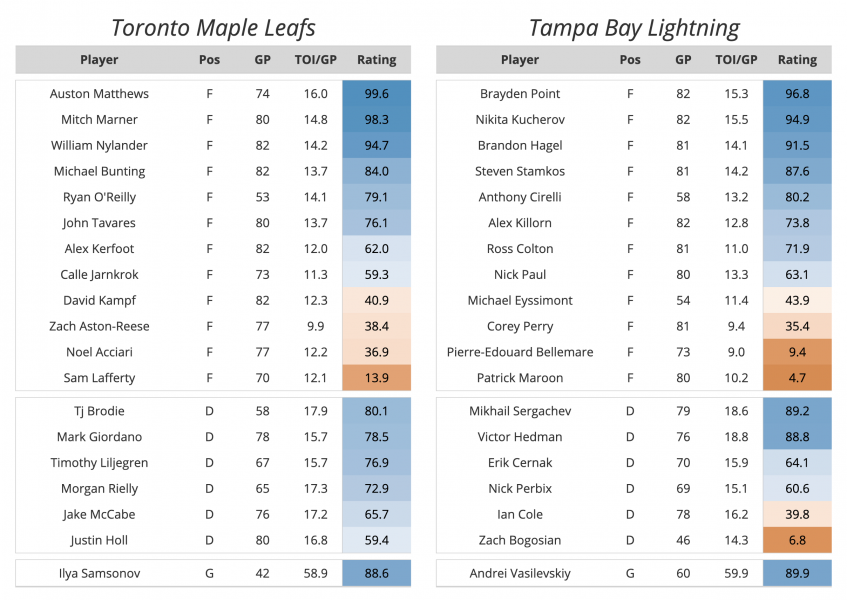It’s that time of year again, eh? Few things are more exciting than the NHL playoffs. The ’22-23 NHL regular season is officially in the books, and the three of us (Josh, Luke, and Shawn) are doing our third playoff preview for the site. This past regular season was quite something. The Boston Bruins set new all-time records for wins (65) and points (135) in a single season. While skater points are something we don’t cover often, we’d be remiss if we didn’t acknowledge Connor McDavid and Erik Karlsson’s staggering point totals (153 and 101 respectively). We also saw eighteen 40-goal scorers including former cast-a-ways Tage Thompson, Carter Verhaeghe, and Jared McCann. For fans of those whose team’s intentions were to win (let’s not talk about the tank right now), it was truly a memorable season. But now it’s time to set aside the 82-game marathon and dive head-first into the playoffs.
As you’ll see below, most of the home teams are favored, which is possibly to be expected. However, we have some marquee matchups in the first round. Notably, New Jersey and New York [insert Sopranos meme here]. The Blueshirts faithful are still scarred from Adam Henrique’s damage in the 2012 Eastern Conference Finals (Shawn wrote this, don’t get mad at me). The East also features a reset of the fantastic Toronto – Tampa series that went seven games last year. Carolina is still an insane analytics darling by our metrics, and the Panthers are looking to do the most hockey-thing-ever by defeating this year’s Bruins in the first round. Out west, we have the battle of the North Stars (I wish this decided who gets to keep the name) and a truly even series between the Knights and Jets. Edmonton has high hopes of making a long run this year as arguably the Western Conference favorites, and the Seattle Kraken are playing in their first playoff series ever.
As we normally note here, our projections (and the playoffs in general) are fun. We treat this as pure entertainment. Anything really can happen, and it’s fun trying to predict what that anything might be. Below you’ll find our series recaps, done to the best of our ability, along with some additional quips and notes. With that, let’s jump in.
Model Info
Our playoff probabilities are generated in a three step process. We use multiple models to project “future” values for all players, use these player projections to build a game probability model that projects the winning % of any given team matchup (logistic regression), and then feed these individual game probabilities into a Monte Carlo simulation that generates the probabilities for each series. In order to complete this process, each team’s player projections are aggregated into F/D/G groups, and various metrics are used for each group which are then fed into the game probability model. With these inputs, we are able to generate home and away team winning percentage values. Once we have projected all home/away probabilities for the playoff games, we prepare the simulation.
For the simulation, in a given game, we only care about the projected winning % for the home team. Take BOS/FLA. The process laid out above gives us a winning % for each team. In game 1, BOS is the home team. We replace FLA’s projected probability with a random % between 0 and 1 since they are the away team. If BOS’s projected winning % is higher than the random number, BOS “wins” that game (they “lose” if it is lower). In game 3 when FLA is the home team, we do the same for BOS (we replace their winning % with a randomly generated %). This is done for each team game in all series and then repeated 50,000 times. Once the simulation is complete, we check how many times each team won a game, sum the total games won in a series, and arrive at each team’s projected probability.
The first step is generating multiple player-level models which produce ratings for all players in the league. For skaters, we found our xSPAR metric (Expected Standing Points Above Replacement) as well as a custom “game score” model (built using Box Score metrics) worked best for predicting future team game outcomes. Our SPAR and RAPM metrics were also tested but they did not perform quite as well for this specific task. The “game score” model we are using is similar to Dom Luszczyszyn’s Game Score model; however, we tested various box score metrics and weighted them through a “grid search” approach to optimize predicting future team game win probability.
Eastern Conference
Boston Bruins (A1) vs. Florida Panthers (WC2)
66.0% 34.0%
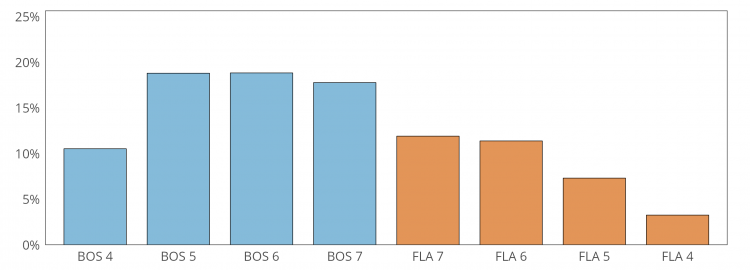
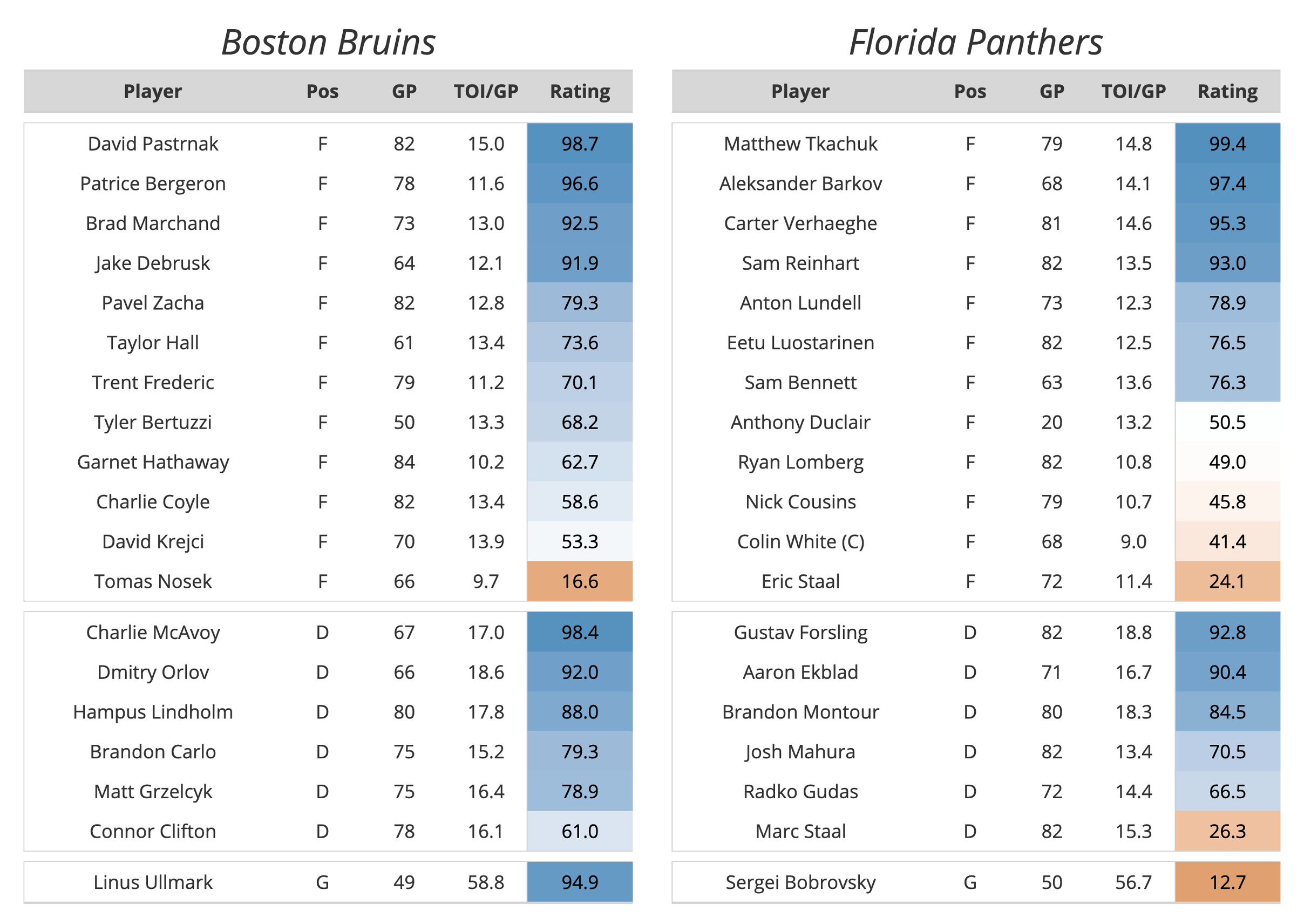
The Boston Bruins head into the first round series with an immense amount of pressure on them. As we all know, the 2018-19 Tampa Bay Lightning were swept in the first round of the playoffs after tying the NHL wins record of 62. The Bruins appear unfazed after blowing past that record with 65 wins, ending the season on an eight-game winning streak and carrying the phrase, “Committed to the process,” as their playoff motto. From Charlie McAvoy and Hampus Lindholm to David Pastrnak and Patrice Bergeron, the Bruins have a pocket full of riches. Their third line of Taylor Hall and Tyler Bertuzzi on the perimeter of Charlie Coyle, and their potential to spread the wealth on the back end with one of Dmitry Orlov, Charlie McAvoy, and Hampus Lindholm on the ice at all times becomes a matchup nightmare for opponents. Linus Ullmark has also been mightily impressive this season, assuming you manage to get past the Bruins skaters. Will the Bruins pass the first test of the postseason, or will they end up like the Lightning?
BOS strengths: Pretty much everything
BOS weaknesses: Maybe their powerplay?
The Florida Panthers are a team that our models kept faith in throughout the season. Even when things looked bleak in February, the playoff projections still held them above a coin flip to make the playoffs. Thanks to [checks notes] Alex Lyon coming up big for the Cats down the home stretch, the model was rewarded for its loyalty. We love that for it (patting the model on the head). The star of the show for the Panthers is offseason acquisition, Matthew Tkachuk. As a former gym classmate of Jason Tatum, the St. Louis native finished the season second among skaters in GAR (28.8) and sixth in xGAR (31.2). Strapped by the cap, the Panthers relied on their superstar to deliver, and he did. On the back end, Brandon Montour had a career year. He finished tenth among defensemen in GAR (15.9) and fourteenth in xGAR. The Panthers are built to frustrate their opponents with their speed, physicality, and general peskiness. While the odds are not in their favor, they’re ready for a fight.
FLA strengths: Matthew Tkachuk, used to warmer weather
FLA weaknesses: Special teams, goaltending
Toronto Maple Leafs (A2) vs. Tampa Bay Lightning (A3)
66.1% 33.9%
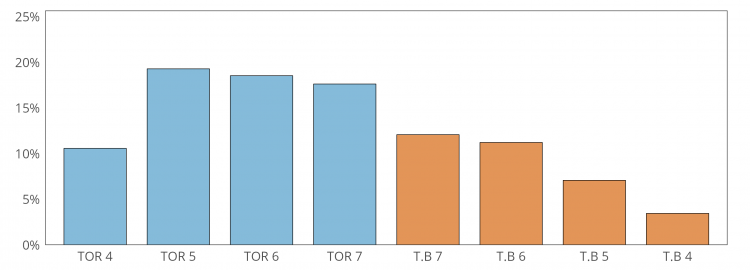
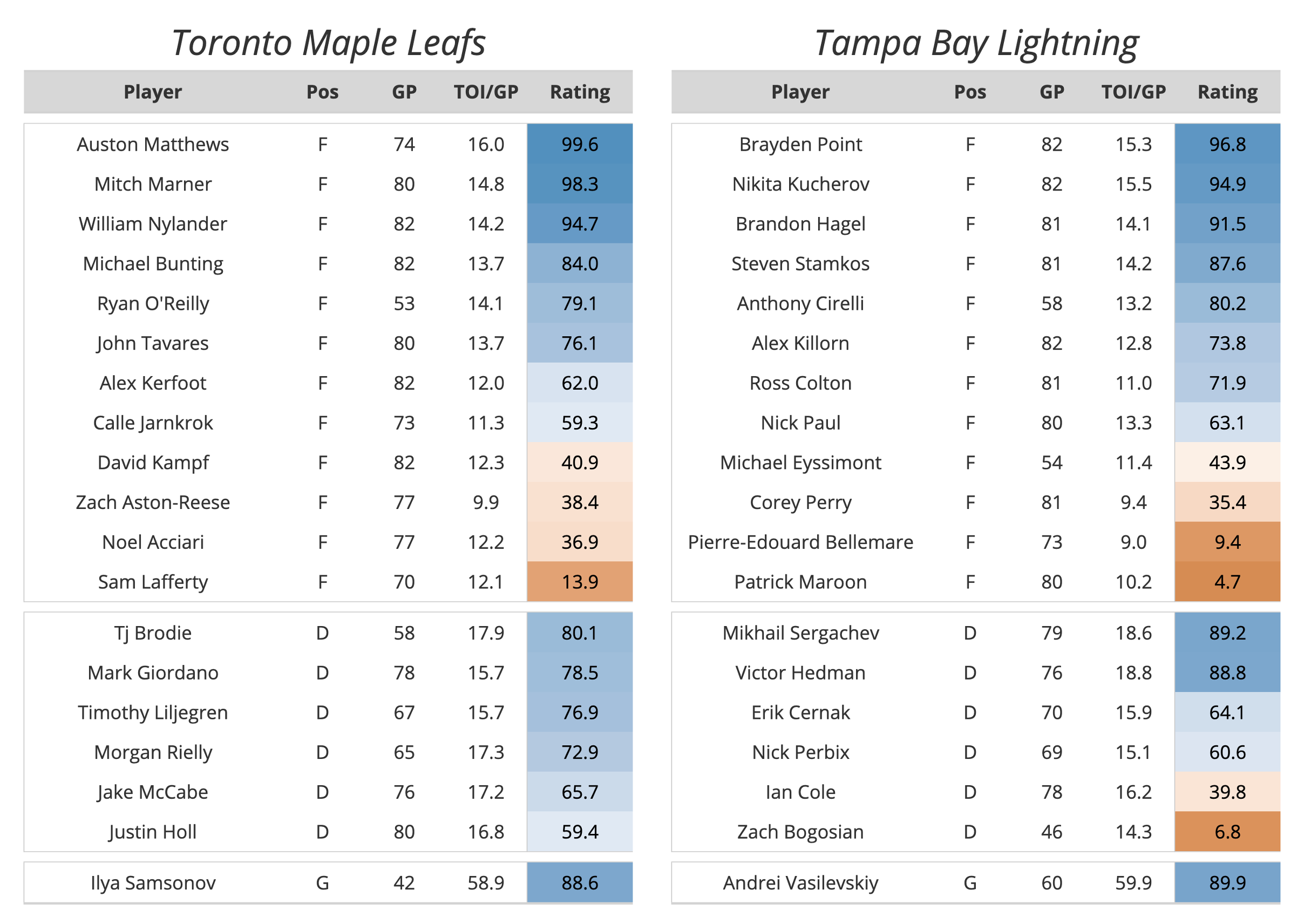
We get it. For the last few seasons, it felt like this was the time Toronto would break their first round curse. The 2021 Canadiens should’ve been a walk in the park for the Leafs, but they blew a 3-1 series lead. Last year, the Leafs looked primed to take the series from the Lightning, but they gave up games six and seven for another disappointing but begrudgingly expected series loss. This season, well, we have them favored again like just about everyone else, of course. Last season was the Auston Matthews show heading into the postseason, winning all of the regular season awards he could. This season, there have been big contributions from other members among their big four. Mitch Marner had a spectacular year, and William Nylander cracked the 40-goal mark for the first time in his career. Kyle Dubas also went out and acquired more depth at the deadline, most notably picking up former Stanley Cup champion Ryan O’Reilly. While the Leafs have been overshadowed in the east by the Bruins, Canes, and Devils, they still have a strong team that can contend, and our models like that.
TOR strengths: Star power up front, TJ Brodie on the back end
TOR weaknesses: Goaltending uncertainty
It feels dangerous to count out the Lightning. They’ve made the last three Stanley Cup Finals, winning the first two and losing to a formidable Avalanche team last season. Our models really do frown on the Lightning this season though. Brayden Point hit the 50-goal mark and was among the league leaders in GAR and xGAR, but the team fell off a bit after that. Victor Hedman was not his usual dominant self this season – he finished below replacement level in both GAR and xGAR. The Lightning also don’t have as strong of a fourth line as last year. Heading into the postseason a year ago, the Perry-Bellemare-Maroon line had a 75% share of goals. That line never came to fruition this season. And the Lightning fell behind their opponents at the deadline with their only acquisition being Tanner Jeannot who had a rough year with the Predators and Lightning this season. But as Leafs fans know, this team is something to fear.
T.B strengths: Brayden Point, goaltending
T.B weaknesses: Depth, Hedman struggling
Carolina Hurricanes (M1) vs. New York Islanders (WC1)
78.7% 21.3%

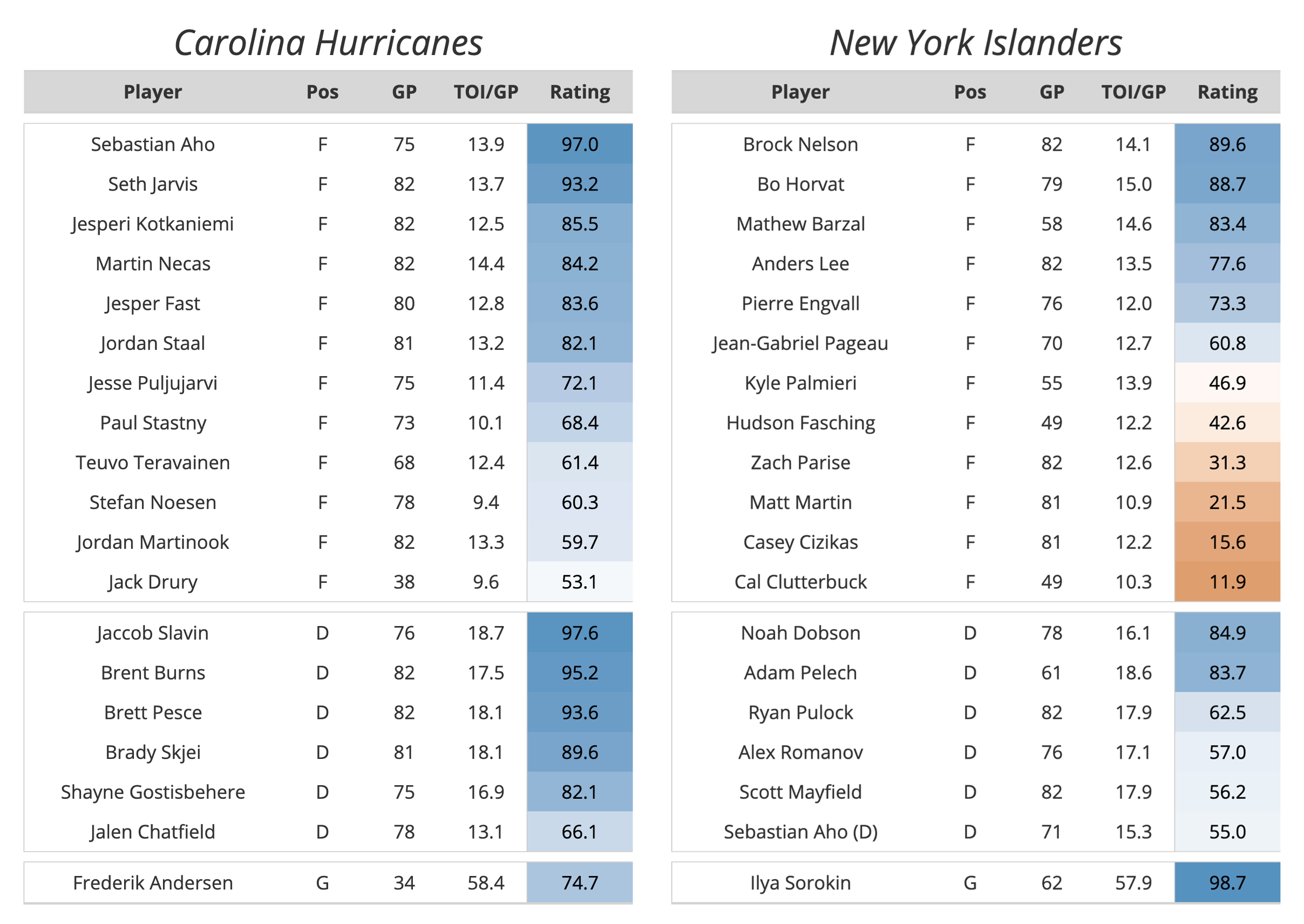
The Hurricanes metrics at 5-on-5 this season were outright ridiculous. Their score and venue adjusted Corsi For % of 61.5% is the highest of any team since the NHL’s RTSS data was introduced (07-08). Their share of expected goals (59.9%) is also the top mark for an 82-game season since 07-08. They’ve just looked like they were on another planet in those tables all season. However, if you head on over to the goal differential components tab, you’ll see that the Hurricanes only finished fifth in 5v5 goal differential per 60 minutes this season. The biggest reason why is an estimated 0.59 goals lost per 60 minutes from below average shooting. The addition of Max Pacioretty, whose season ended shortly after coming back from injury, was supposed to help this. The lack of finishing while facing potentially the best goaltender in the league might spell trouble for the Hurricanes, but they will certainly smother the Islanders with shot attempts. This could turn out to be a very low scoring series (with absurd Corsi metrics).
CAR strengths: Controlling play, good depth
CAR weaknesses: Finishing
The New York Islanders of 22-23 are built on a solid bedrock: goaltending. Ilya Sorokin is that rock. The Russian goaltender is in his third season in North America, and, we should note, it was a fantastic one. He finished second to Jusse Saros in GAR among goaltenders (49.4) over the course of 62 games played. He will be the key factor if the Islanders are able to upset a strong Carolina Hurricanes team. This season’s Islanders are a bit quicker and a bit more aggressive than in years past, but they’ve essentially placed themselves as an average team with great goaltending. Their powerplay has struggled significantly, which is definitely a concern in the playoffs. This team is probably the most boring in the east, but they could change that with an upset over Carolina.
NYI strengths: Goaltending, defense
NYI weaknesses: Powerplay
New Jersey Devils (M2) vs. New York Rangers (M3)
72.1% 27.9%

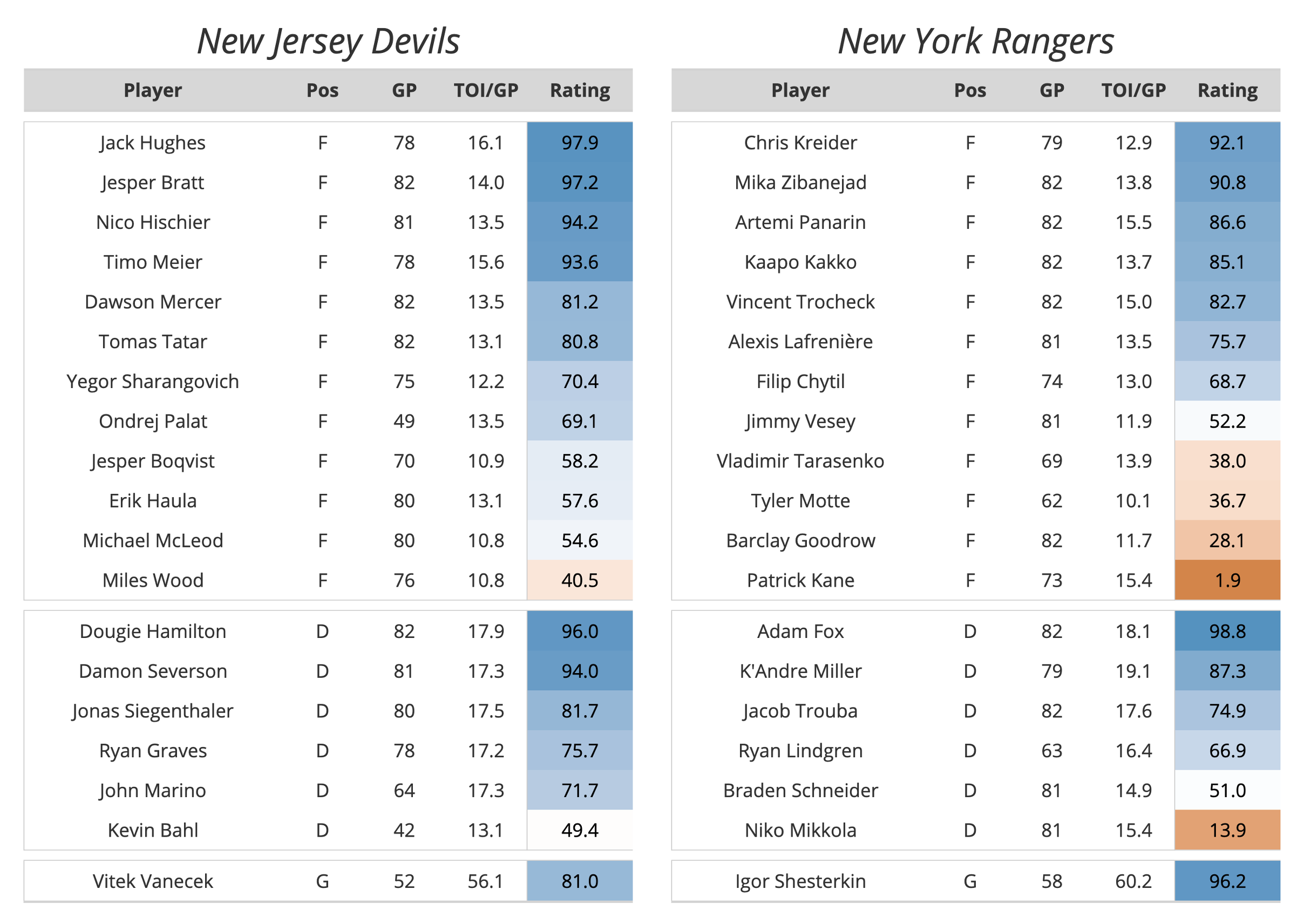
After our season projections were incredibly high on the Devils last season (which fell short), this season was the one that saw the dream realized. This Devils team didn’t have horrendous goaltending, and their skater depth was able to lead them to the second seed in the Metropolitan Division. When it came to the deadline, New Jersey went for it, acquiring the top available player in Timo Meier. An already deep team with Jack Hughes, Jesper Bratt, Tomas Tatar, and Dougie Hamilton got even deeper (not to mention Damon Severson’s incredible season). Vitek Vanacek, the Washington Capitals pick for the Seattle Kraken in the expansion draft, has offered some stability in goal. This team doesn’t have a bad player on it, placing them as one of the favorites in the east. There was a bit of volatility throughout the season, but this is a very strong team.
N.J strengths: Incredible depth, out possessing opponents
N.J weaknesses: Maybe their lack of experience?
Okay…look…our stuff really [really] doesn’t like Patrick Kane. Public opinion may vary. His traditional box score stats may be fine, but we aren’t going to cheat you here either. The Rangers have decided to build their team to be great finishers, often sacrificing defense. The team last year had similar problems heading into the postseason. Last year’s team saw another incredible performance from Igor Shesterkin, something you can probably bet on having happen again this postseason. The kid line of Chytil, Lafreniere, and Kakko also shined – this time around the model seems to like them (especially Kakko). Will there be another unsung hero for the Rangers in their quest to defeat their enemies from across the river? Or will they return disappointed?
NYR strengths: Scoring, goaltending
NYR weaknesses: Defense, depth
Western Conference
Colorado Avalanche (C1) vs. Seattle Kraken (WC1)
61.9% 38.1%


Last year’s Stanley Cup champions fell on some exceptionally hard times this season; few teams struggled with injuries the way the Avalanche did. Not to mention losing several key players to free agency last year (Nazem Kadri and Andre Burakovsky). Despite this, the Avalanche still managed to take the top spot in the Central (albeit after the season had officially ended). Nathan MacKinnon, in only 71 games, finished 3rd among all skaters in GAR, and Mikko Rantanen & Cale Makar (in only 60 games) finished top-30 in xGAR. Among all teams, Colorado’s 6.3 Corsi Differential RAPM at even-strength ranked 5th. Possibly most (or least surprising if you’ve been following this team for several years) has been the Av’s goaltending: Alexander Georgiev’s 28.4 GAR placed him 9th in the league. One of the big question marks with this team is their depth: are they really going to run out any combination of Erik Johnson, Jack Johnson, Alex Galchenyuk, and Kurtis MacDermid? It worked, to a degree, last year, but our projections really do not like a certain few players the Avalanche may be rostering. Regardless, the Avalanche, with a healthy Nichushkin, are likely the favorites in the West.
COL strengths: top-tier talent, they’re the Avalanche and always seem to figure something out
COL weaknesses: injuries, surprisingly bad depth
The crazy folks in Seattle did it. After a strong offseason last summer with the additions of Burakovsky and Bjorkstrand, and a breakout first year from the almost guaranteed Calder winner Matty Beniers, the Kraken broke 100 points for the first time (ok fine, it’s just their second season and ok fine they finished with exactly 100 points). Seattle’s depth proved quite important with strong seasons from Daniel Sprong, Will Borgen, and Eeli Tolvanen. But one player powered this team unlike any other player in the league: Jared McCann. His 32.1 xGAR was 5th among all skaters this season, and a pair of twins may have even had him as a potential Hart finalist. Sure, most of his value came from shooting, but all his EV RAPM numbers have been quite strong. With the help of the revitalized Vince Dunn, and a bounce-back year from Phillip Grubauer in net, our model has been and continues to be quite high on this year’s Kraken team. One thing to look out for, however, is Seattle’s league leading 10.4% EV shooting percentage. Initially this was one of our closer projected series, but with a few roster changes for Colorado (namely adding in Makar), the Avalanche have taken the edge. Regardless, it’s always fun to watch a new team make their playoff debut. Especially one as fun as the Kraken.
SEA strengths: Depth, Jared McCann
SEA weaknesses: Shooting sustainability, middling EV numbers
Dallas Stars (C2) vs. Minnesota Wild (C3)
68.7% 31.3%
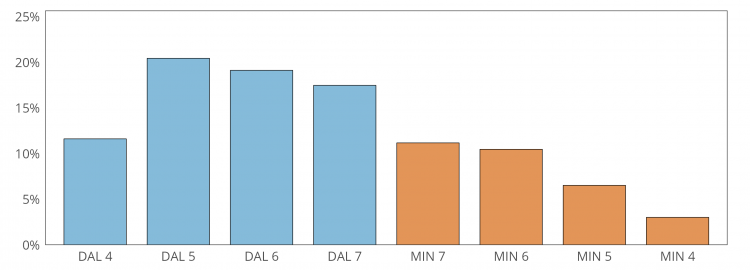
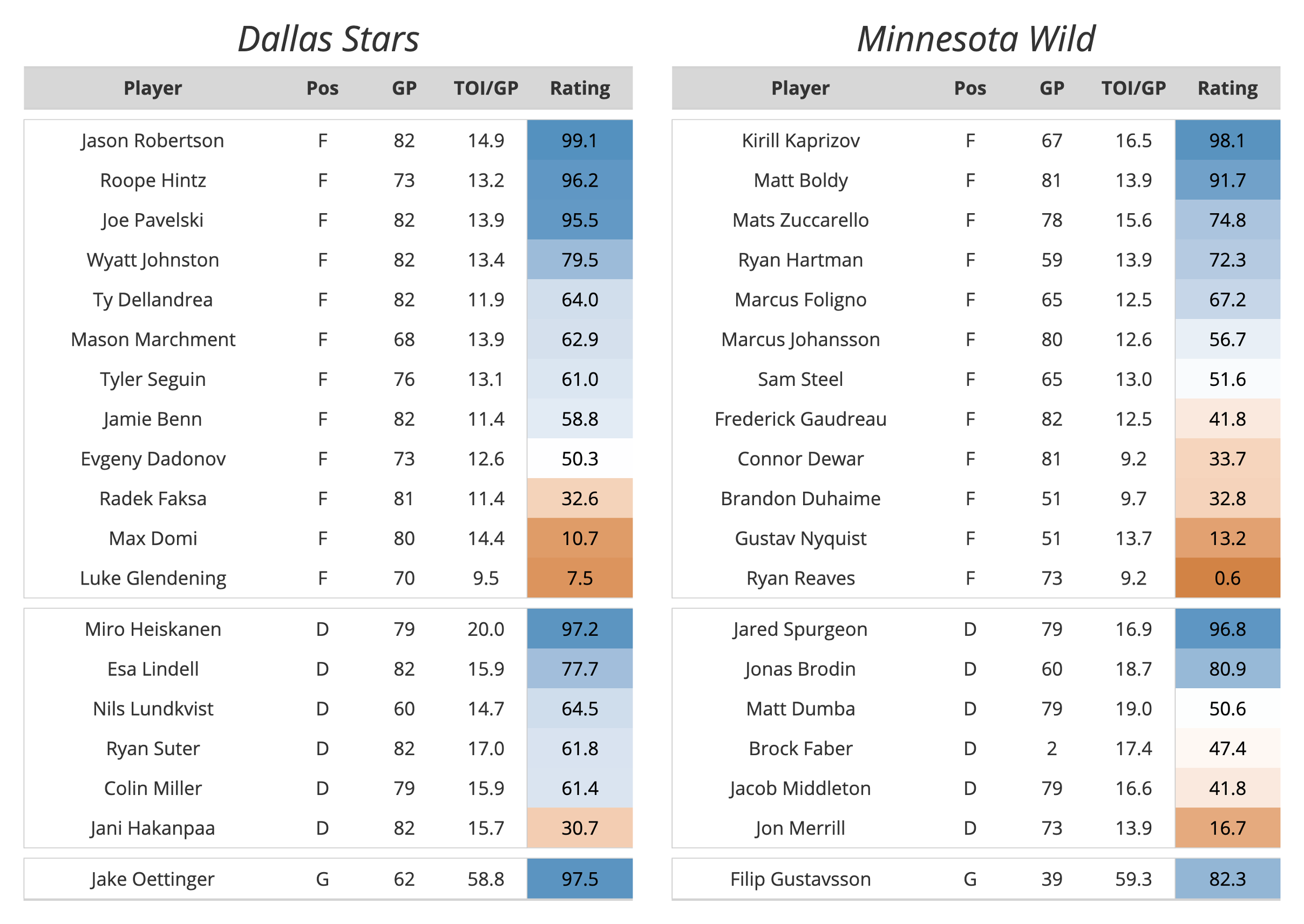
Only Boston and Edmonton finished the season with longer winning streaks than the Dallas Stars, who were this close to taking the Central division’s first spot. Dallas is, well, a strange team. A combination of elite young players and aging veterans with big names. If anything, the Stars may have been one of the most consistent teams this season: at even-strength, their GF, CF, and xGF differentials were all 11th in the league. At the core, this is a team that relies heavily on an incredible top forward line of Jason Robertson, Roope Hintz, and Joe Pavelski, who played the most minutes together of any forward line in the league. These three also led the Stars in xGAR (in that order). With Jake Oettinger in net, who did not disappoint after last postseason’s incredible performance, finishing 8th in GAR for goalies. The Stars’ biggest weakness, however, is the aforementioned reliance on one forward line. Jamie Benn and rookie Wyatt Johnston’s production this year was a nice surprise, but if Robertson, Pavelski, and Hintz can’t carry this team for a game or two, the rest of the lineup is surprisingly thin. But who am I kidding? That’s not going to happen. Jason Robertson.
DAL strengths: best line in hockey, best playoff goalie in hockey?
DAL weaknesses: over-reliance on top players, age
The Minnesota Wild. America’s team (although they almost lost that title to the Sabres). I noted last year how this Wild team is completely different from years past. But this season’s team looked an awful lot like last season’s team. Kirill Kaprizov, Jared Spurgeon, and Matt Boldy carried the Wild to 103 points, while a certifiably rag-tag group filled out the rest of the lineup. Out of necessity due to the $13M ghosts of Parise & Suter, the Wild relied heavily on a rotating group of relatively unknown players. The biggest surprise for Minnesota was the emergence of Filip Gustavsson, taking the place of Cam Talbot after last summer’s trade. Finishing 5th in GAR, no Wild goalie has ever been more valuable in a season. While it’s not clear who will get most of the games in net, we have Gustavsson as the #1. The Wild have battled some injury issues this season, and the uncertainty surrounding Eriksson Ek and Johansson will also play heavily into what their depth looks like, which is admittedly lacking. I wouldn’t be surprised if the Wild call on a few AHL players to take the place of more well-known names like late-season addition John Klingberg. Ultimately, this series comes down to one line, defensemen, and goalie against their counterparts. Does it bode well for either team’s Cup odds? Probably not. Will it make for a good series? Hell yeah it will. This is the Minnesota Wild baby.
MIN strengths: Kaprizov, Spurgeon, Boldy, and Gustavsson
MIN weaknesses: everything else
Vegas Golden Knights (P1) vs. Winnipeg Jets (WC2)
48.4% 51.6%
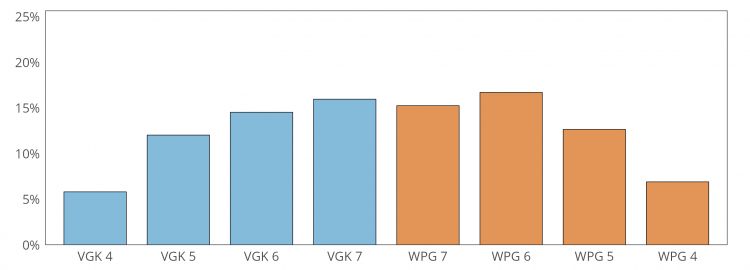
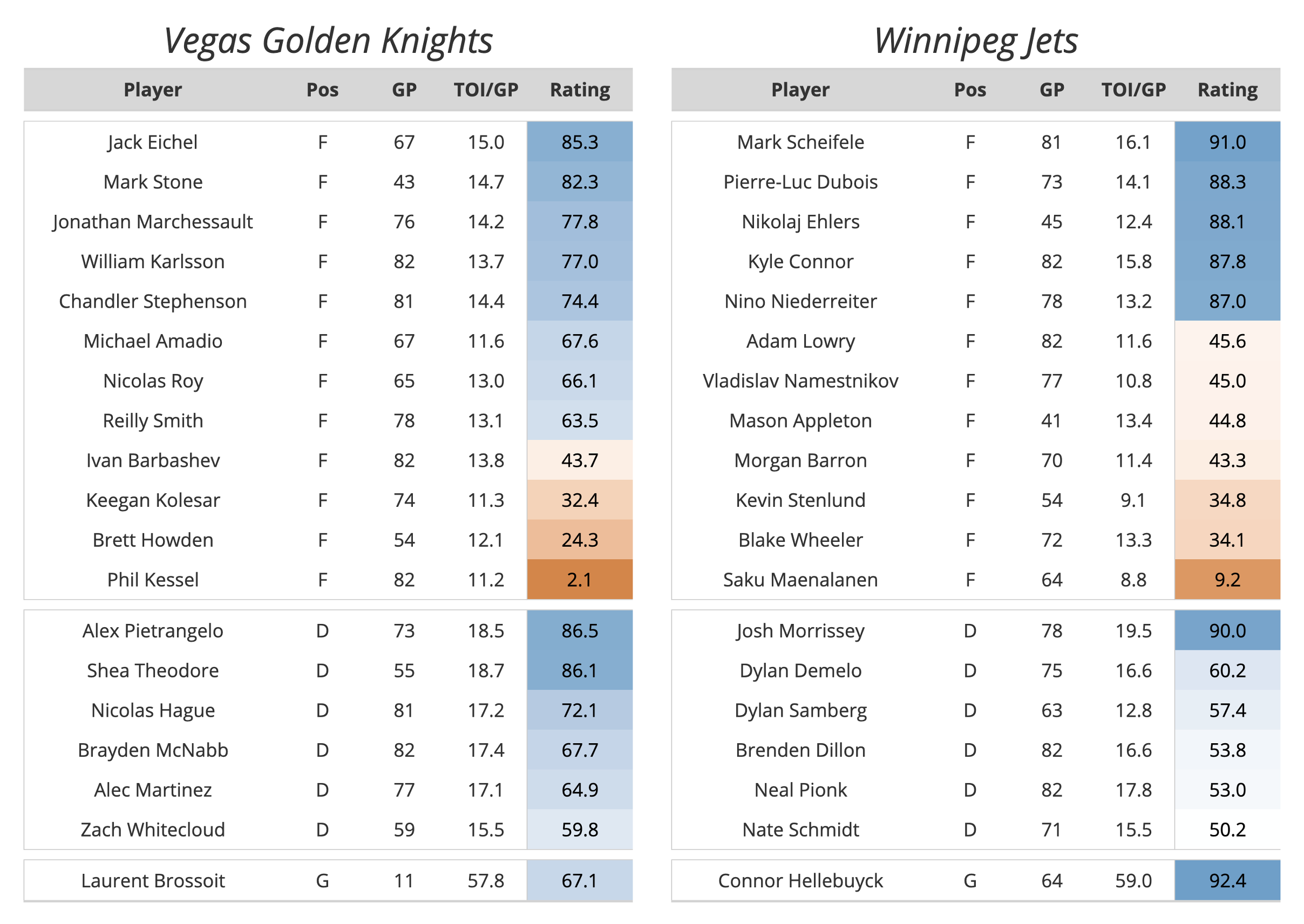
Possibly one of the most under-cared about teams in the NHL (mostly their own doing), the Golden Knights head into this year’s playoffs as the Pacific champs. With 111 points, Vegas may have been the most injured team in terms of impact-players of any team in the NHL. Only three of their skaters played 82 games (Karlsson, McNabb, and Kessel), and only seven other players played more than 70 games. They also relied on 5 goaltenders throughout the course of the season, none playing more than 40 games. Despite this, the Knights still managed a top-10 EV xGF and GF differential per our RAPM model. To be honest, it’s quite impressive they managed to succeed the way they did without any real shooting bender (15th in shooting percentage) or extreme goaltender performance. Vegas seems to be a true sum of its parts, with few weak links (save Kessel and Howden). If the Knights can avoid any further injuries, they have Eichel, Stone, Pietrangelo, and Theodore to carry them, and supporting pieces like McNabb, Carrier, and Amadio fill out a rather solid overall roster. The main concern, or what our model is probably worried about, is what kind of team Vegas actually is given the extremely uncertain roster over the past year.
VGK strengths: resilience, Mark Stone and company
VGK weaknesses: health, goaltending uncertainty, no one likes them
Oh The Jets. A couple good skaters, often mismanaged (especially the good ones), and Connor Hellebuyck. Don’t get me wrong, Winnipeg has some pieces here. Josh Morrisey had a true breakout year, Mark Scheifele found himself again, and Nino, Connor, and Dubois round out a solid group among their forwards. Not to mention the promising emergence of Dylan Samberg and the production from analytics darling Nikolaj Ehlers. But the Jets continue to rely on one thing: Hellebuyck. No goalie has put up more GAR or played more games in the last five seasons than Hellebuyck. The team hasn’t changed that much, all things considered. Outside of their goaltending, they still have a solid D group, with Dillon, Demelo, and Samberg providing defensive contributions in front of Hellebuyck. The real question will be whether a middling skater group and possibly the best goalie in the league is enough to make it past the first round. Regardless, this is the closest series we’re projecting. There is quite a bit of assorted uncertainty underneath both Vegas and Winnipeg. The only real constant is Connor Hellebuyck. If I was a betting man, I’m not sure I could bet against him.
WPG strengths: Connor Hellebuyck
WPG weaknesses: middling skater group, management
Edmonton Oilers (P2) vs. Los Angeles Kings (P3)
64.8% 35.2%
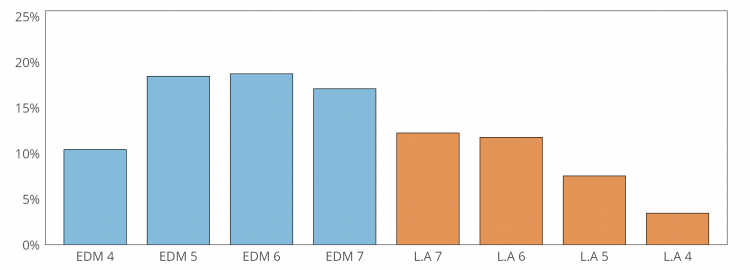

I feel like I’ve written this exact same Edmonton preview for the last three years. Connor McDavid and Leon Draisaitl with some guys. There you go, that’s the preview. That’s what I’d like to say here just because it’s funny, but Edmonton really has built up a solid team. They have Stuart Skinner now, who legitimately should maybe win the Calder. RNH, Evan Bouchard, and Zach Hyamn had fantastic seasons, and their top-4 D are remarkably strong. But this team, more than any team I can remember, is a powerplay. Draisiaitl, RNH, and McDavid posted top-20 all-time xPPO numbers this season, and no team has ever come close to Edmonton’s RAPM PP numbers; their 5.3 GF/60 on the powerplay was more than a full goal above the next best team on the powerplay (Tampa in ’18-19). Edmonton has the incredibly luxury of running out McDavid and Draisaitl for 30 minutes every game, and this year their supporting cast is possibly the best we’ve seen during the McDavid Era. The one thing they have this year that’s new is a young, great goalie in Skinner. We’d all love to see McDavid lift the Cup, but in a seven-game series, it can’t be that hard for the Kings to stay out of the box, eh?
EDM strengths: powerplay, surprisingly strong supporting cast
EDM weaknesses: what happens if they don’t get a powerplay
For a team that is still, in a way, rebuilding, finishing third in the Pacific isn’t a bad way to take the next step. The Kings flew under the radar compared to their California peers this season, but they have managed to post some quality numbers the last two years, finishing with top-10 EV Corsi and xG differentials, as they develop a new core. Still led by the always underrated Anze Kopitar and probably just properly rated Drew Doughty, Adrian Kempe, Matt Roy, and Phillip Danault have turned the Kings into a dark horse in the West. Kevin Fiala, LA’s big offseason acquisition last summer, hasn’t panned out the way they may have hoped so far, but he’s still a major threat whenever he’s on the ice. Gabriel Vilardi, however, has a been a bright spot for the Kings this season. Like several other teams, the Kings’ main concern will likely be goaltending. While trading Jonathan Quick likely improved the team, and Joonas Korpisalo has played quite well this year for both the Blue Jackets and now Kings, his previous two seasons were quite different. Regardless, Los Angeles has a surprisingly well-rounded lineup despite lacking the fire power of their opponent. Edmonton is favored by our model, but I wouldn’t be surprised if the Kings make this series interesting.
LA strengths: well-rounded, sneaky
LA weaknesses: lack of elite talent, goaltending
And with that, let’s go.
– The Evolving Hockey Team
